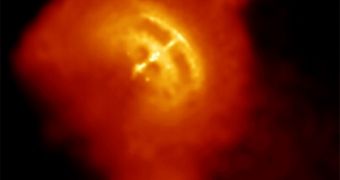A group of astronomers from the US National Radio Astronomy Observatory (NRAO) recently used the National Science Foundation's (NSF) Green Bank Telescope (GBT) to observe a triple star system located very close to Earth, which will from now on be used as a real-world gravitational laboratory.
The extremely interesting object lies around 4,200 light-years away from Earth, and is made up of two white dwarf-class stars and an extremely-dense neutron star. These objects orbit so close to each other that all three can fit in a space with a diameter smaller than one Earth-Sun distance (AU).
The reason why astronomers are so excited about this triple object is that all the stars within it interact with each other in numerous ways that have never been analyzed before. By studying these gravitational interplays, scientists may gain new knowledge on how such stars behave in the Universe.
Additionally, scientists say, it may be possible to use this system to understand the true nature of gravity, an issue in fundamental physics that has yet to be resolved to date. The millisecond-pulsar (a type of neutron star) in the triple system spins around its axis around 366 times per second.
“This triple system gives us a natural cosmic laboratory far better than anything found before for learning exactly how such three-body systems work and potentially for detecting problems with General Relativity that physicists expect to see under extreme conditions,” says NRAO investigators and study team leader, Scot Ransom.
Millisecond pulsars such as this one are of great use for astronomers since they spin at a constant speed. They can be used for a variety of scientific studies, potentially even in searching for elusive gravitational waves. These are distortions in spacetime that are predicted by the theory of gravity, but which have not been identified in reality yet.
“The gravitational perturbations imposed on each member of this system by the others are incredibly pure and strong. The millisecond pulsar serves as an extremely powerful tool for measuring those perturbations incredibly well,” Ransom explains, quoted by EurekAlert.
GBT data were supplemented by readings collected with the Arecibo radio telescope, the Westerbork Synthesis Radio Telescope in the Netherlands, the Sloan Digital Sky Survey, the NASA GALEX satellite and Spitzer Space Telescope, and the WYIN telescope in Arizona.
“This is a fascinating system in many ways, including what must have been a completely crazy formation history, and we have much work to do to fully understand it,” Ransom concludes. Details of the system were published in a paper that appears in the January 5 online issue of the top scientific journal Nature.

 14 DAY TRIAL //
14 DAY TRIAL //